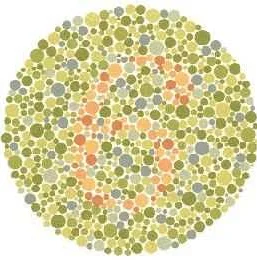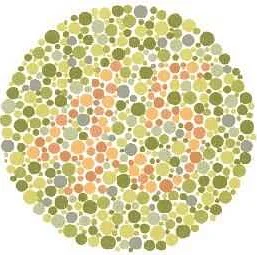Test yourself: a simple test for color blindness in six pictures
Содержимое
Take a simple color blindness test using six pictures. Check if you can easily distinguish between different colors and see if you have color vision deficiency.
Color blindness is a condition that affects a significant percentage of the population. It is a visual impairment that makes it difficult for individuals to distinguish certain colors. While it may not seem like a serious issue, color blindness can have a significant impact on a person’s daily life. From choosing clothes to navigating traffic lights, color plays a crucial role in our perception of the world.
Have you ever wondered if you are color blind? Do you struggle to identify certain shades or have difficulty telling the difference between similar colors? If so, you may want to take a color vision test. These tests can help identify whether you have any type of color vision deficiency, such as red-green color blindness or blue-yellow color blindness.
One simple and fun way to test your color vision is by looking at a series of pictures specifically designed to reveal color blindness. These pictures, known as Ishihara plates, consist of colored dots and patterns that can only be seen by individuals with normal color vision. By studying these images, you can gain insight into your color perception and determine if you may have any form of color blindness.
Take a few minutes to explore these six simple pictures and see if you can spot the hidden numbers or shapes within them. Keep in mind that if you have trouble identifying the hidden figures or if the colors appear distorted to you, it could be an indication of color blindness. Don’t worry if you find it challenging – color blindness is relatively common, and there are plenty of resources available to help individuals manage and cope with this condition.
Test Yourself: Discover Color Blindness
Color blindness is a condition that affects the ability of individuals to perceive certain colors. It is more common in men than in women, with approximately 8% of men and 0.5% of women being color blind. Despite its name, color blindness does not mean that a person can only see in black and white. It refers to the deficiency or absence of certain cone cells in the eyes, which are responsible for perceiving different colors.
If you suspect that you or someone you know may be color blind, there are simple tests that can help you identify this condition. The Ishihara color test is one of the most well-known tests for color blindness. It consists of a series of plates with dots of different colors and patterns. By looking at these plates, individuals with normal color vision can see numbers or shapes, while color blind individuals may see different numbers or no numbers at all.
Another test is the Farnsworth-Munsell 100 Hue Test, which requires individuals to arrange colored tiles in order of hue. This test assesses their ability to accurately discriminate between different shades of color. Color blind individuals may struggle to arrange the tiles correctly, indicating their color vision deficiency.
Recognizing color blindness is important, as it can affect daily tasks and activities. For example, color blind individuals may have difficulty distinguishing between colors in traffic lights, maps, or even in distinguishing ripe fruits from unripe ones. By identifying color blindness, individuals can take appropriate measures, such as using assistive devices or seeking professional advice, to help them navigate their daily lives more effectively.
If you are curious about your color vision, you can try some online color blindness tests or consult an eye care professional for a comprehensive evaluation. Remember, identifying color blindness is the first step towards finding solutions and accommodations to make life easier for those affected by this condition.
| Ishihara color test | A test that uses plates with dots of different colors and patterns to identify color blindness. |
| Farnsworth-Munsell 100 Hue Test | A test that requires individuals to arrange colored tiles in order of hue to assess color vision deficiency. |
Six Simple Pictures for Color Blindness Detection

Color blindness is a condition that affects a person’s ability to perceive certain colors. It can be a challenging condition to detect, as individuals with color blindness may not be aware of their color deficiency. Fortunately, there are six simple pictures that can help in the detection of color blindness.
These pictures are specifically designed to test the different types of color blindness, including red-green color blindness and blue-yellow color blindness. By examining these pictures and the individual’s response to them, color blindness can be identified.
1. Ishihara Test: This test uses a series of plates with different colored dots that form numbers or patterns. Individuals with color blindness may not be able to see the numbers or patterns clearly.
2. Farnsworth-Munsell 100 Hue Test: This test requires the individual to arrange colored tiles in the correct order of hue. Color blindness can be indicated if the tiles are not arranged correctly.
3. Pseudoisochromatic Plate Test: This test includes plates with colored dots in various patterns. Individuals with color blindness may not be able to distinguish the dots from the background.
4. Color Arrangement Test: In this test, the individual is asked to arrange colored chips in the correct order. Color blindness can be detected if the chips are not arranged accurately.
5. Color Naming Test: This test involves naming the colors of objects or symbols. Individuals with color blindness may struggle to correctly identify certain colors.
6. Color Matching Test: This test requires the individual to match colors using printed swatches or computer screens. Color blindness can be indicated if the colors are not matched accurately.
By using these six simple pictures, color blindness can be easily detected. It is important to note that these tests should be conducted by professionals for accurate results. Early detection of color blindness can help individuals receive the necessary support and accommodations to effectively navigate the world of color.
Understanding Color Blindness: Causes and Types

Color blindness is a visual impairment that affects the perception of color. People with color blindness may have difficulty distinguishing certain colors, often confusing them or seeing them differently than others. This condition is typically inherited and occurs more frequently in males than females.
The most common cause of color blindness is a genetic mutation that affects the photopigments in the cone cells of the retina. These cone cells are responsible for detecting different colors of light. When the photopigments are abnormal or missing, the brain receives incorrect information about the colors being viewed, resulting in color blindness.
There are different types of color blindness, depending on which photopigments are affected. The most common types include:
- Protanopia: People with protanopia have a reduced sensitivity to red light. This means they have difficulty distinguishing between red, green, and brown.
- Deuteranopia: Individuals with deuteranopia have a reduced sensitivity to green light. They may have difficulty differentiating between green, yellow, and red.
- Tritanopia: Tritanopia is a rare form of color blindness that affects the perception of blue light. People with this condition may have trouble distinguishing between blue and green, as well as between yellow and violet.
In addition to these main types, there are also other variations and degrees of color blindness. Some individuals may have milder forms of color blindness, while others may have a complete inability to perceive certain colors.
Understanding the causes and types of color blindness is important for both individuals with the condition and those interacting with them. By increasing awareness and knowledge about color blindness, we can create a more inclusive and accommodating environment for everyone.
How Color Blindness Affects Everyday Life

Color blindness, also known as color vision deficiency, is a condition that affects an individual’s ability to distinguish between different colors. This condition occurs when the cones in the eye, which are responsible for detecting colors, do not function properly.
Color blindness can have various impacts on everyday life. For example, individuals with color blindness may have difficulty distinguishing between red and green, which are commonly used in traffic lights and road signs. This can pose a safety risk when driving or crossing the road.
In addition, color blindness can also affect educational and professional settings. For instance, color-coded graphs, charts, and maps may be challenging to interpret accurately. This can result in difficulties in understanding information or making informed decisions based on visual data.
Furthermore, color blindness can affect personal relationships and social interactions. For example, individuals with color blindness may struggle to match clothing or coordinate colors for special occasions. This can lead to self-consciousness or embarrassment in social settings.
Fortunately, there are strategies and technologies available to help individuals with color blindness navigate everyday life. For instance, color filter glasses or apps can enhance color perception and assist in tasks that rely heavily on color differentiation. Awareness and understanding from others can also contribute to creating an inclusive environment for individuals with color blindness.
It is important to recognize that color blindness is a unique experience for each individual, and its impact can vary. By raising awareness and understanding about color blindness, we can foster inclusivity and ensure that everyone has equal opportunities in all aspects of life.